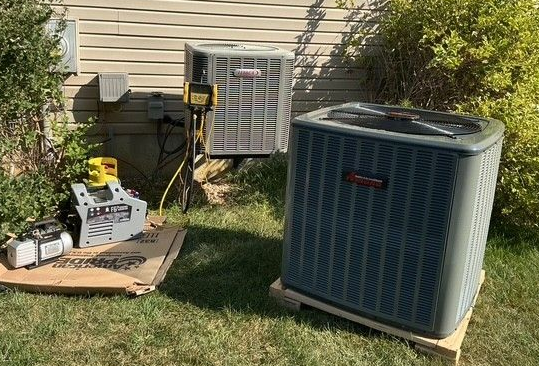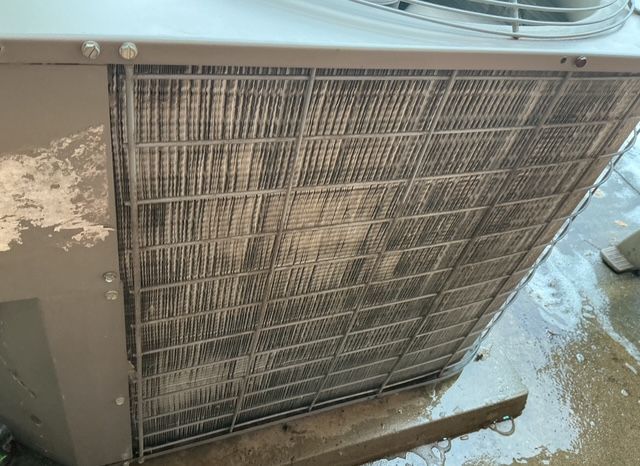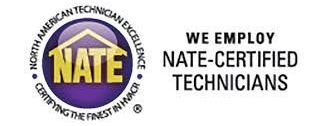Repair or Replace Your Air Conditioner?
Weighing the Costs, Benefits, and Timing of AC Repairs vs. Replacement

Signs Your Air Conditioner Needs Repair or Replacement: A Homeowner’s Guide
Is your air conditioner running but not cooling? Or maybe your energy bills are rising without explanation? Knowing when to repair or replace your AC can save you money, prevent stress, and keep your home comfortable year-round.
This guide walks you through common warning signs, helpful rules, repair vs. replacement considerations, and AC installation options, so you can make an informed decision.
Common Signs an AC Unit Needs Repair
Some of the most common indicators your AC may need servicing include:
- Thermostat issues: The AC isn’t reaching the set temperature.
- Rising energy bills: A clogged system or failing component can increase electricity use.
- Water around the furnace: Could indicate a frozen coil caused by a clogged filter or low refrigerant.
- Loud or unusual noises: Could signal a failing motor or debris trapped in the system.
- Weak or uneven airflow: Suggests blocked ducts, a dirty filter, or blower problems.
- Bad odors: Musty smells can indicate mold in the system; burning smells may point to electrical issues.
- Short cycling: AC turns on and off rapidly, wasting energy and straining components.
If you notice any of these signs, contact True Blue Home Services to schedule a professional diagnosis and repair.
Warning Signs Your AC May Need Replacement
Sometimes repair isn’t enough. Consider replacing your AC if:
- Your unit is 10 years or older.
- Large components (coil, compressor) need replacing.
- You need to add refrigerant repeatedly.
- Cooling is inconsistent or air isn’t cold.
- Repairs are becoming frequent and costly.
- Your system uses outdated refrigerants (R-22 or older R-410A).
Repair vs. Replace: How to Decide
Deciding whether to repair or replace your AC depends on age, repair costs, performance, and long-term savings.
The $5,000 Rule
A helpful starting point is the $5,000 rule:
- Get a professional repair estimate.
- Find the age of your AC unit.
- Multiply repair cost × unit age.
- Less than $5,000: Repair may be the smarter choice.
- More than $5,000: Replacement is often the better long-term investment.
Example:
- 12-year-old AC with a $400 repair → 12 × $400 = $4,800 → Repair makes sense.
- 10-year-old AC with a $600 repair → 10 × $600 = $6,000 → Replacement likely better.
Limitations: Don’t rely on the $5,000 rule alone. Consider frequent repairs, rising energy costs, refrigerant type, comfort issues, and how long you plan to stay in your home.
Other Helpful Rules
- The 50% Rule: If a repair costs 50% or more of a new AC, replacement is usually more cost-effective.
- The 10–15 Year Rule:
- Under 10 years → repairs are usually fine for minor issues.
- Over 10 years → system is nearing the end of its lifespan; replacement should be strongly considered.
- Frequent Repairs Rule: Constant breakdowns add up in cost and inconvenience—often signaling replacement is smarter.
- Refrigerant Rules:
- R-22 systems: Phase-out makes repairs expensive; replacement is often necessary.
- R-410A systems: Phase-out began in 2025; replacement may be prudent for older units needing major repairs.
- Energy Efficiency Rule: Older units have lower SEER ratings. Newer ENERGY STAR units can reduce cooling costs 20–40%.
When to Repair
- Less than 10 years old.
- Minor, inexpensive repairs (e.g., clogged drain, capacitor replacement).
- Repair cost is less than 50% of a new system.
- You plan to move soon and don’t want a major investment.
When to Replace
- 10–15 years old or older.
- Frequent, costly repairs.
- Uses outdated refrigerants.
- Rising energy bills due to inefficiency.
- Poor or inconsistent cooling, hot/cold spots, or humidity issues.
How to Make the Right Decision
- Get a professional diagnosis: A licensed HVAC technician can provide repair estimates and replacement options.
- Request multiple quotes: Compare at least 2–3 contractors.
- Use the rules together: Combine the $5,000 rule, 50% rule, and age guidelines.
- Consider long-term costs and benefits: Factor in energy savings, reliability, and comfort improvements.
- Check incentives: Rebates, tax credits, and utility programs may offset replacement costs.
Prolonging the Life of Your Air Conditioner
- Schedule annual maintenance.
- Change air filters every 1–3 months.
- Keep the outdoor unit free of debris.
- Ensure vents are open and unobstructed.
AC Installation Options
True Blue Home Services installs a variety of systems:
- Standard and High Efficiency Air Conditioners.
- Ductless Air Conditioners: Ideal for home additions, sunrooms, or upper floors with poor airflow.
- Heat Pumps: Provide both cooling and heating, are energy-efficient, and run quietly.
Preparing for AC Installation
When buying a new system, consider:
- Proper sizing: True Blue performs a full load calculation to ensure the AC meets your home’s needs.
- SEER rating: Higher SEER = greater energy efficiency and lower bills.
- Single vs. Two-stage systems: Two-stage units provide better humidity control and efficiency, ideal for long-term comfort.
Frequently Asked Questions (FAQ)
Q: Why is my AC running but not cooling?
A: Common causes include a dirty air filter, low refrigerant, frozen coils, blocked ducts, or a malfunctioning thermostat.
Q: How long does an air conditioner last?
A: Most central AC units last
10–15 years, with modern units sometimes reaching
up to 20 years if properly maintained.
Q: Should I repair or replace my AC?
A: Use a combination of guidelines: the
$5,000 rule, the
50% rule, unit age, repair frequency, and energy efficiency. Minor repairs on newer units are usually worth it, while older or inefficient units are often better replaced.
Q: How do I know what size AC I need?
A: AC sizing depends on
square footage, insulation, windows, and airflow. True Blue Home Services performs a full load calculation to ensure your unit is properly sized.
Q: What is the SEER rating, and why does it matter?
A: SEER (Seasonal Energy Efficiency Ratio) measures AC efficiency. Higher SEER ratings mean lower energy bills and better long-term savings.
Q: Can I switch from R-22 to a newer refrigerant?
A: Yes, but older systems may not be compatible with new refrigerants like R-410A without major modifications. In many cases, replacing the system is more cost-effective.
Q: How can I extend the life of my AC?
A: Schedule annual maintenance, change air filters regularly, keep the outdoor unit clear of debris, and ensure proper airflow through vents.
Call the Local AC Experts
For fast, reliable AC repair, replacement, or installation in St. Charles and surrounding areas,
call or text True Blue Home Services at 636-459-4528.
From repairs to new installations, we’re here to keep your home cool, efficient, and comfortable year-round.



